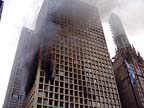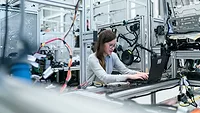Safe Steps on Stairs

A 2003 fire in the 35-story Cook County (Chicago) Administration Building was typical of such tragedies, with locked stairwell doors that prevented people from re-entering building floors when they encountered heavy smoke in a stairwell.
In high-rise offices, it is a common practice to lock stairwell doors to prevent criminals from entering offices, committing theft and leaving via the stairwells. Sometimes doors are locked only at the end of a business day; but in more buildings today, doors are always locked above the first floor.
Search for solutions
One of the earliest approaches, which focused on stairwell security, was to lock all doors to prevent re-access from the stairwell side. Signs were posted that all doors were locked until the ground level.In many localities, codes or ordinances were changed to require that doors be left unlocked at intervals, such as on every fifth floor. While this helped provide a safe emergency escape, it also compromised security.
Some systems make it possible for a person in authority to open the locks on all floors from a central location, although this requires a specific action that may not be possible or practical in all emergencies.
Systems now are available that automatically release the locks on stairwell doors of all floors when a fire alarm is sounded. One such solution is an electrified breakaway lever trim such as the Von Duprin E996L. It incorporates a 24VDC solenoid that can be energized from a distant controller. When the fire alarm system is activated, it acts as an on-off switch for the electrified lever and turns the power off. This unlocks the lever so a person can rotate it and retract the latch bolt, allowing the door to be opened. As an added benefit, the lever incorporates a breakaway design that operates normally when unlocked but yields if more than 35 pounds of torque pressure is applied when it is locked. This prevents vandalism or forced entry by breaking the latch, and the lever is easily re-set.
The electrified lever trim on the stairwell (pull) side of the door is paired with a standard mechanical exit device on the push side to allow safe egress at all times. When the stairwell doors are locked, anyone entering the stairwell will not be able to re-enter the building areas and generally will have to exit at ground level. For security reasons, the ground level doors typically open to the outside. However, when the fire alarm system is activated, a person can re-enter at any level because the levers all will unlock automatically.
Essentially, it is a fail-safe mode, although the design can be set to fail secure where allowed. This might be the preferred option in non-stairwell locations, such as the back door of a jewelry story, where a power interruption would otherwise leave the door unlocked.
This type of system has other applications as well. For instance, a receptionist who is monitoring a stairwell door or other entrance equipped with an electrified lever trim could have a pushbutton on the desk that would shut off power to the lever and allow someone to enter if recognized.

Sidebar: Live Demos of Fire/Life Safety Solutions
Hands-on, face-to-face is always the best way for end users to learn about new systems and the experts behind the technology. That’s the aim of the Worldwide Visitor Center just opened by SimplexGrinnell at its Westminster, Mass., facility. “The Worldwide Visitor Center is an important resource for SimplexGrinnell,” says Dave Baer, vice president of marketing. “Our experience has been that major business opportunities can be positively influenced by a visit...It gives clients a chance to see, touch and operate our systems and solutions. This all-important ‘test drive’ provides customers with added confidence.”Looking for a reprint of this article?
From high-res PDFs to custom plaques, order your copy today!



